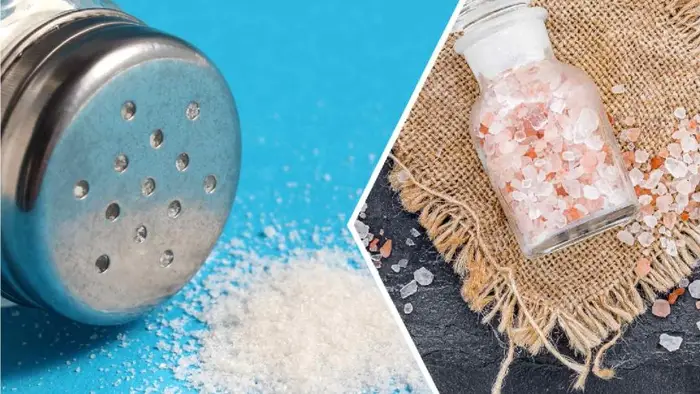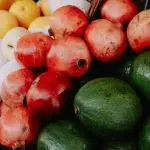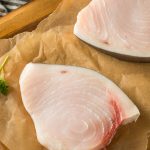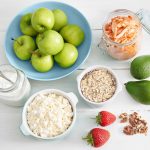Pink salt and common salt have completely different colors, tastes and vitamins. So, discover out who received with the pink salt and common salt dialogue.
Salt is likely one of the fundamental substances extensively utilized in getting ready varied forms of meals. You may also sprinkle some whereas consuming salads or crispy fries. Nevertheless, the dangers related to extreme consumption of sodium, an vital ingredient in salt, might discourage you from having common salt or desk salt in a spoon. Sure, consuming an excessive amount of sodium can result in hypertension and coronary heart illness. So, does that imply you must search for more healthy choices like pink salt? Earlier than you create a change, take a look at the comparability of pink salt and common salt.
What’s Pink Salt?
Earlier than we transfer on to the pink salt vs. common salt dialogue, let’s begin with the fundamentals. Pink salt or Himalayan salt receives its title from the place it’s mined. It comes from historical deposits of salt within the Himalayan mountains. “The pink shade of salt is attributable to hint minerals like iron oxide,” says dietitian Haripriya. N. As a result of it’s handled to a minimal, the product is unrefined and, as is, thought of to be extra pure than common salts.

What’s common salt?
Unusual salt, also referred to as desk salt, is probably the most generally used salt in households. “It is often very refined, with many of the impurities and minerals eliminated throughout processing,” consultants say. In accordance with the US Facilities for Illness Management and Prevention, one teaspoon of standard salt comprises about 2,400 mg of sodium. Far more than really helpful. The US Meals and Drug Administration says that you must eat lower than 2,300 mg of sodium per day.
Pink Salt and Regular Salt: What are the similarities?
Pink salt and common salt aren’t simply the distinction. There are similarities too.
- Main parts: Each are primarily made up of sodium chloride, which causes a salty style. “However pink salts often include 84-98% sodium chloride. Common salts include 97-99% sodium chloride,” says Haripriya.
- Cooking Use: Each are used to season meals, improve taste and preserve meals. It can be used whereas cooking, on the desk, or for pickles or curing.
- Well being Influence: “Over-intake of both kind can contribute to an elevated threat of hypertension (hypertension) and coronary heart illness,” consultants say. It might probably additionally result in kidney pressure and water retention. That is why low sodium meals are wholesome.

Pink Salt and Common Salt: What is the Distinction?
The important thing variations between pink salt and common salt are as follows:
- sauce: Usually salt is mined from underground salt deposits, however the pink color comes from the Khewra Salt Mine close to the Himalayas in Pakistan.
- course of: “The standard ones are very refined and include components like anti-anti-resistant brokers,” consultants say. Pink ones are handled to a minimal. Pure and unsleek.
- Principal substances: Common salts include 97-99% sodium chloride, whereas pink salts include 84-98% sodium chloride with hint minerals.
- Added vitamins: “Regular salts are often iodinated to stop iodine deficiency,” says Haripriya. There is no such thing as a added iodine within the pink kind of salt.
- Hint minerals: These are largely faraway from the common salts throughout purification. Pink salt, however, comprises over 84 minerals. A few of them are calcium, magnesium, manganese, and potassium, in accordance with a research revealed in Meals.
- shade: The important thing distinction between pink salt and common salt is the colour. The traditional ones are vivid white, whereas the Himalayan ones are pink.
- texture: Common salt is a uniform, fantastic grain. Pink salt is often coarse and can be out there in fantastic and flake varieties. “However if you would like an analogous quantity measurement to desk salt, you must select fine-grained pink salt,” the knowledgeable suggests.
- style: Pink salt and common salt discussions can not ignore the style. The common salt is pure salty and barely sharper, whereas the pink one is mildly salty and has a delicate mineral taste.
- Well being Advantages: “Regular salts can stop iodine deficiency when iodized,” consultants say. Nevertheless, to keep away from shortages, there are some meals wealthy in iodine, similar to seaweed, dairy merchandise, and eggs. Pink salt improves digestion, helps hydration and electrolyte stability, and prevents fatigue. You may also have pink salt for weight reduction. It is no surprise why pink salt methods are trending on-line.
- Cooking Use: Common salt can be utilized in on a regular basis cooking, baking, and desk seasonings. Pink salt can be used for cooking, however is primarily added to gourmand dishes, or grilled or seasoned meat.
- Non-skin use: Common salt is used for gargling to assist relieve sore throats. Pink salt is utilized in tub soaks and skincare scrubs.
There is no such thing as a clear winner in pink salt and common salt discussions. Whether or not pink salt is healthier than common (desk) salt will depend on what you are on the lookout for. Is it style, minerals, well being advantages, or iodine content material? So select them in accordance with your wants.
Associated FAQs
Which salt is the healthiest?
There is no such thing as a “healthiest” salt. For common use, iodized desk salt is in small quantities to make sure iodine consumption. Pink salt, sea salt and celtic salt are good choices should you get sufficient iodine out of your weight-reduction plan.
Can I exchange desk salt with pink salt?
Sure, more often than not you possibly can exchange desk salt with pink salt. Pink salt can be utilized like desk salt for seasonings, cooking, and garnishings. It has a light style and provides a delicate mineral taste.
How is Himalayan salt completely different from sea salt?
Himalayan salt and sea salt are each thought of “pure” alternate options to common desk salt, however they’re completely different. For instance, Himalayan salts are pink or reddish as a consequence of hint minerals similar to iron oxide. Sea salt is often white or mild grey.
How a lot salt is protected to eat?
Salt is important on your physique, however an excessive amount of may be dangerous to your coronary heart, kidneys and blood stress. Adults can eat 5 grams (1 teaspoon) per day.
Disclaimer: At HealthShot we’re dedicated to offering correct, dependable and genuine data to assist your well being and well-being. Nevertheless, the content material on this web site is for informational functions solely and shouldn’t be thought of an alternative choice to skilled medical recommendation, prognosis or remedy. At all times seek the advice of a professional healthcare supplier for personalised recommendation about your particular medical situation or concern.










